Planning 2 days in Milan and want advice on how to best organize your days to maximize your time in northern Italy’s capital city?
This is the guide for you!
Northern Italy is my second home and I’ve spent a lot of time in Milan over the years. It’s a glamorous city full of things to see and do, and of course, has no lack of delicious food and drink to try either! This can make building your itinerary for Milan a challenge, especially when there are likely a lot of places you want to visit on your Italy trip with only so many vacation days.
To save you the stress, I’ve written this complete Milan 2-day itinerary guide complete with:
- things you must do before you arrive in Milan with important travel tips,
- where to stay in Milan advice,
- a complete day-by-day itinerary with maps and metro information, and
- alternative itinerary ideas to help you customize your time in Milan.
How Many Days in Milan Make Sense?

Milan is one of the world’s fashion capitals and is famous for its cultural scene. But Milan is so much more! This cosmopolitan city is also a place with centuries-old history, a blend of modern and historic architectural sights, and renowned art masterpieces. It’s simply an unmissable destination in the Lombardy region of northern Italy.
Because of this, one of the most asked questions is how many days in Milan make sense.
Of course, we all know it’s impossible to truly get to know any city in just a few days. But, with so many incredible places throughout Italy, 2 days in Milan strikes the right balance. And, even though it’s possible to see a couple of top sights with just one day in Milan, adding just one more day will pay dividends to your overall experience.
If Milan is the first stop on your trip to Italy, the extra day will give you a little cushion in case of flight delays or severe jet lag. The pacing of your itinerary can allow for some breathing room for the chance to explore the city a bit more, not to mention if you run into any hiccups.
And, you’ll also have time to enjoy at least 1 night (if not 2) discovering Milanese cuisine and Italy’s aperitivo culture which first took root here.
So, are you ready? Let’s get planning your trip to Milan!
What to Do Before Your Trip to Milan
To ensure your trip to Milan is everything you hope it’ll be, there are a few essential things you’ll want to plan well before arriving. Even though Milan may be somewhat overlooked in favor of cities like Venice, Florence, and Rome, the city’s most popular activities and hotels book fast.
Book tickets in advance for Milan’s top sights.
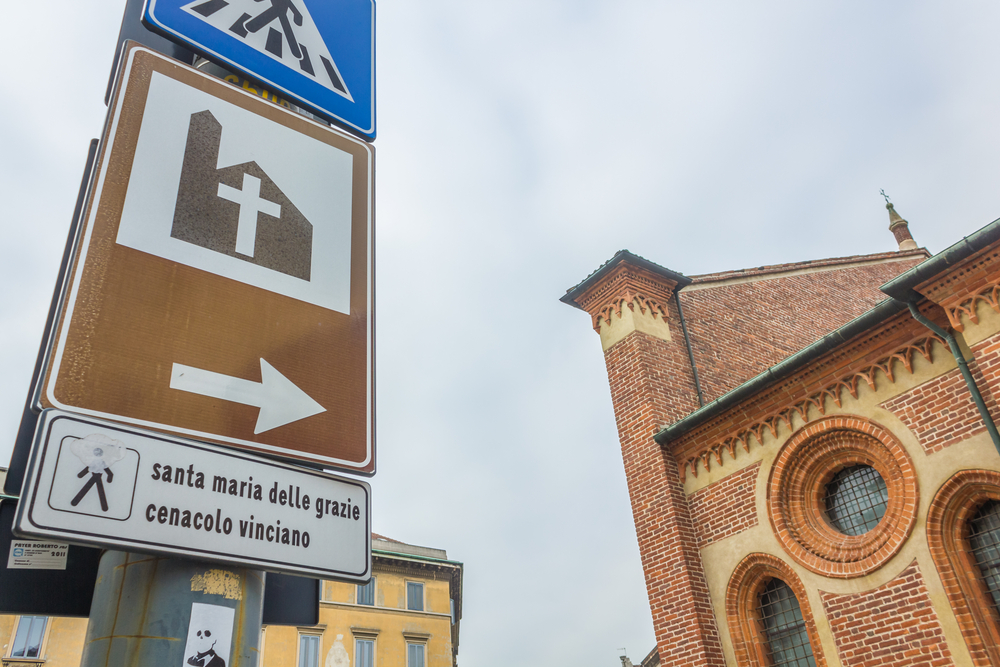
You’ve certainly seen this advice again and again across numerous travel websites. Generally, this is always a wise idea because wasting time waiting in line or discovering that a top sight is sold out is not the type of memory you want to return home with. On top of this, booking in advance lets you choose the best timed-entry timeslots for your schedule, as opposed to booking the remaining entry times and having to rework your day around them.
Particularly in Milan, tickets to see Leonardo Da Vinci’s Last Supper can sell out months in advance as each block of tickets is released. This is largely because visitors to see the famous masterpiece are limited to a certain number each day to help preserve the life of the artwork. You absolutely must book your tickets as early as possible if you want to include this in your Milan itinerary.
Tickets for the Last Supper can be booked on the official website. Everything you need to know about getting access to the Last Supper can be found in this guide.
If you check the website for tickets and find your dates sold out, all hope isn’t lost. You can also see the Last Supper with a guide, but even this should be arranged in advance so you have access to the dates and times you need.
ProTip: Ideally, you’d schedule your visit to the Last Supper in the morning to be among the first visitors of the day.
After this, reserve your entry time to see Milan’s famous Duomo and rooftop terrace. Lines can be very long at the ticket booths outside the famed Cathedral. And while you will find a bit more flexibility in booking Duomo tickets, the coveted times of the day do book up early. My recommendation is to get the fast-track ticket with lift access, particularly when you’re trying to see Milan in 2 days.
And if you’re planning to visit both the Last Supper and the Duomo, you want to make sure the timed entries for both don’t overlap or create a situation where you are running or miss your time slot. This is especially the case for the Last Supper.
Decide where to stay in Milan.
Like many big cities, Milan is made of a series of neighborhoods. Each comes with its own character and, of course, some are more centrally located than others.
With 2 days in Milan, most of your time is likely to be spent in the Centro Storico which also includes Brera, the artist’s neighborhood. Here you’ll find many art galleries (and the famous Pinacoteca di Brera) while being just steps away from Piazza del Duomo, Castello Sforzesco, and Parco Sempione. Staying directly within the Centro Storico or the Brera will help maximize your sightseeing time by limiting how long it takes to get from your hotel to the city’s top sights. There are also numerous connections with Milan’s metro system to help you get around the city quicker.
As you’d imagine, staying in such a prime location comes with a cost. But luckily, there are hotels at a variety of price points from the 5-star Park Hyatt Milan and Bulgari Hotel Milano to Room Mate Giulia and UNAHOTELS Cusani Milano.
Alternate areas to look for hotels in Milan are Isola and Navigli, active day and night, as well as Corso Buenos Aires known for its shopping and general proximity to Milano Centrale, the central train station. Just keep in mind that although hotel prices may be less in these areas, you’ll be further from Milan’s top sights. So try to position yourself as close to a metro stop as possible because of the city’s metro, trams, and buses, the metro tends to be the quickest to learn.
If you’re traveling as a family or with a group, you might want to consider renting an apartment for more space without having to pay for additional hotel rooms.
Plan your airport transfer.

It’s stressful to arrive in a new place but being stressed isn’t a great way to begin your trip to Italy, or any vacation for that matter. To eliminate this initial overwhelm, plan how you’ll get from the airport to your hotel by taxi, car service, or public transportation.
Understand that driving directly into Milan is not advisable. Many hotels don’t offer parking and the city has traffic limitation zones (ZTLs) where driving is restricted to only those with specific permission to do so. Others are fined for driving in these restricted areas.
Milan has three airports: Milan Malpensa (MXP), Milan Linate, and Milan Bergamo Orio al Serio (BGY). Most travelers coming from North America arrive at Milan Malpensa, the busiest of all the airports in northern Italy.
Malpensa (MPX) is located about 30 miles northwest of Milan’s center. You can take a taxi or arrange a private transfer or use transportation options like the Malpensa Express train or one of several buses from Malpensa. Use this in-depth guide on how to get from Malpensa Airport to Milan’s city center to plan which option is best for you.
Milan Linate (LIN) is located less than 5 miles from the city center. The fastest method to reach the city center is by taxi. The ride costs approximately €40 and takes about 15 minutes depending on traffic. A less expensive option is the bus which you can take to Milan’s city center in approximately 30 minutes.
Bergamo Airport is about the same distance from Milan as Malpensa. This airport is the main low-cost airline airport for the Milan area. If you fly with airlines such as Ryanair and EasyJet, you might land at BGY. The significant distance from Milan makes the transfer from Bergamo Airport rather long and expensive. Taxis and private transfer services will cost you €100 for a 50-minute drive but they will also take you directly to your hotel.
Alternatively, the Orio Shuttle connects to Milano Centrale station. At the time of writing this, the airport shuttle bus runs every 30 minutes between 3 am and 12 am with a one-way ticket costing about €10 when booked online. Additional buses run by several other companies can be booked here and go directly to Milano Centrale, the main train station.
If you take public transportation to Milan Centrale or another central point in the city, you can use the metro or take a city taxi from there to your hotel if the distance is too great to walk.
Familiarize yourself with Milan’s metro system.
Visitors who are in Milan for 2 days will likely use the city’s metro system at least a few times to navigate around the city. It’s convenient and can help you save a lot of time going from point to point
If you’ve used metro systems in other cities around the world, you’ll undoubtedly recognize many familiar features. The city has 5 lines, M1(red), M2(green), M3(yellow), M4(blue), and M5(purple). Lines M1, M2, and M3 are the ones most used by visitors because they make stops in popular places like the Duomo and the city’s train stations. You can use this map to get yourself oriented. As you’ll also see, the M4 line is under construction at the time of writing this in 2023.
The regions serviced by the metro are sectioned off by zones. Visitors typically only need a fare that includes travel within Mi1-Mi3 zones. You can buy individual tickets from the machines in the station or if available, ticket booths operated by a customer service agent. Tickets cost €2.20 and must be stamped upon entry and exit from the metro system.
Daily cards are also available. They are worth it if you plan to use the metro 4+ times within 24 hours.
Even easier, you can also look for the contactless entry points in each station. Just be sure to use the same card to enter and exit the metro system. There should be at least 2 contactless entry points in each metro station. And even if the gates are open for you to exit, be sure to still tap your card so the system knows how to calculate your fare.
Metro stations are well-marked and have maps and signage to help you know the train’s direction of travel. On board, train stop announcements are made in Italian and English.
ProTip: If you’re not sure about riding Milan’s metro, consider a hop-on-hop-off bus pass, even if for just 1 day. There can be a bit of a walk between some of Milan’s sights, for example walking from the Duomo to Santa Maria Delle Grazie, where the Last Supper is, takes about 20-25 minutes.
2 Days in Milan – Day 1
The first day of this 2-day Milan itinerary will lead you through some of the city’s major sights, as well as a few places that might not be on your radar yet. Nevertheless, they are worth a bit of your time. My experience after repeated visits to Milan is that, initially, the city can come across as a bit aloof. But the more you peel back its layers, you find all types of treasures.
The goal of this guide is to help you peel back those layers a bit faster so that you can make the most of your time in Milan.
Today, you’ll start with the area immediately around the Duomo before branching off a bit. Everything is within walking distance, except the visit to the Navigli district at the end of the day, which you can easily reach by metro.
The map above gives an idea of how the day might look regarding distance and where places are in relation to one another. As you can see, this example route goes in a mostly clockwise direction from the Duomo. But all of these places are so close to the others that it’s easy to customize based on your plan for the day.
Duomo di Milano
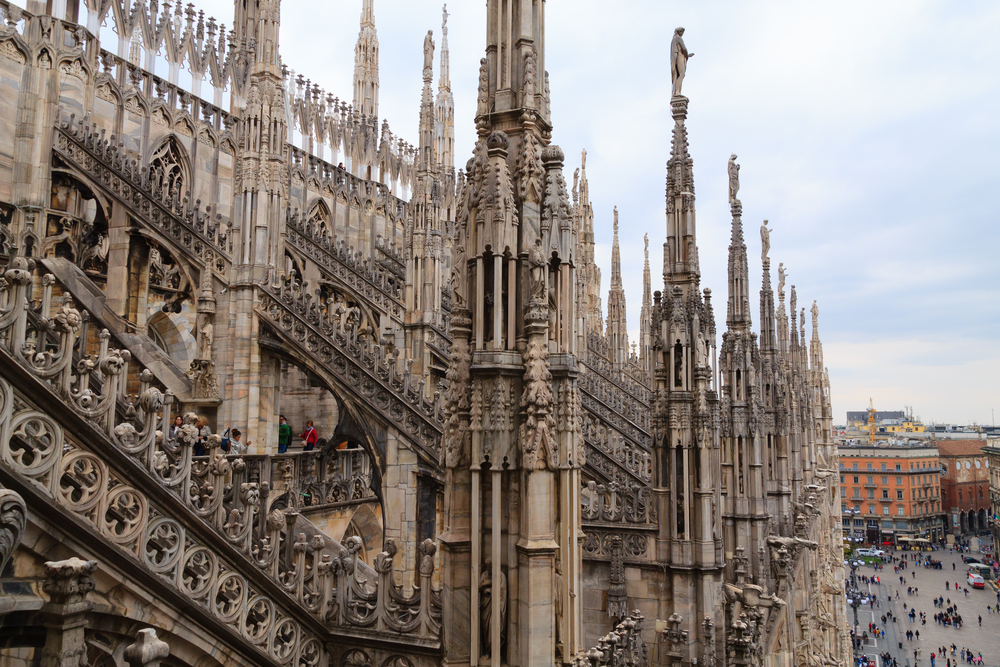
At the center of Piazza del Duomo, stands the stunning Duomo di Milano, the city’s famed Gothic cathedral. Construction began in 1386 and technically finished in 1965, although continuous works are happening at the cathedral to maintain and clean it.
And no matter how many photos you may have seen, there’s no denying the “Wow” factor the first time you spy the famous Duomo! Its pink-hued creamy marble facade adorned with soaring spires and intricately carved statues is an incredibly awe-inspiring sight.
The Duomo di Milano is the largest church in Italy and the second-largest in Europe, after the Basilica di San Pietro in the Vatican. The Duomo has 135 spires, 3,000+ statues, and stands over 350 feet tall! And it’s as impressive on the inside as on the outside. The imposing pillars, one for each week of the year, and the gorgeous floor will catch your attention as soon as you enter.
Perhaps the most spectacular of them all, the rooftop terraces allow you to see the Duomo’s marble and carvings up close. It’s here where you can truly appreciate the extraordinary artisan work that came together to create this architectural masterpiece.
From the rooftop, you also get the added benefit of the from which you can admire a beautiful view of the whole city. From the terrace, you can also admire the details of the iconic “Madonnina”, the statue of the Madonna built in gilded copper and placed on the main spire of the Duomo.
To reach the Duomo’s rooftop terrace, you can climb the (251!) steps or go by elevator. With so many things to do in Milan, I recommend going for the fast-track elevator ticket option. Not only will the elevator get you to the top in seconds, but you’ll also jump to the head of the elevator line which is typically not short even with timed-entry tickets. This can be a tremendous time-saver at the city’s most popular attraction.
In addition, try to get the earliest timed entry possible so that you’re free to move around for the remainder of the day. However, because several other sites are also within steps of the Duomo, it won’t be inconvenient if you have limited entry times for the day of your visit.
Galleria Vittorio Emanuele II

Next to the Piazza del Duomo, you can’t miss the spectacular Galleria Vittorio Emanuele II. The gallery is full of high-fashion boutiques, historic cafes – such as the Marchesi pastry shop, dating back to 1824 – and luxury restaurants.
Inside the Galleria, you’ll also find groups of people stopping in the center of the gallery. On the mosaic floor, you’ll find the coat of arms for Milan, Turin, Florence, and Rome. Particularly with the symbol of the bull for Turin, popular wisdom says that if you turn three times with your right heel at the spot of the bull’s family jewels, there will be good luck coming your way!
Besides being famous for the glitzy shop windows of brands like Prada, Versace, and Armani, the Galleria’s building is seriously impressive, with its glass-dome roof that lets sunlight stream in all day. Given the Galleria’s prime location alongside Piazza del Duomo, you can imagine the views from the Aperol Terrace where you can sip this classic Italian cocktail and take in the incredible views. Look for access via the stairs and, yes, it’s open starting at 11 a.m.
Pro tip: The Piazza del Duomo and Galleria Vittorio Emanuele II are extremely crowded areas. If you’re hoping to take photos without thousands of other people in your shots, go as early as sunrise on one of your 2 days in Milan. On blue-sky days, you’ll also have the first rays of sunlight warming the sky from behind the cathedral.
Teatro alla Scala
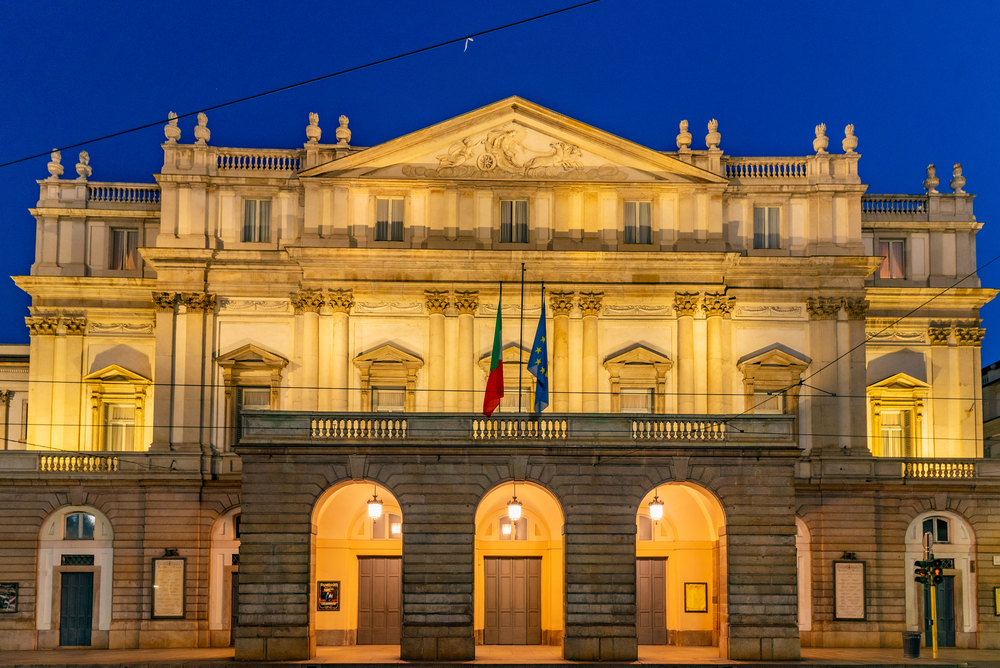
Passing through the Galleria Vittorio Emanuele II, you’ll reach the famous Teatro alla Scala, or La Scala as you may have heard it called. The famous opera house overlooks Piazza della Scala and is one of the temples of Italian opera music. It’s also one of the most famous theaters in the world!
This gorgeous theater was seriously damaged during World War II and rebuilt in record time. In addition to the majestic theater with its red and gilded gold interior, there’s also a museum housing costumes and musical instruments among other things. Luckily, you can visit the theater with a guide to see the inside and visit the museum to learn more about the city’s musical history.
If you’re not interested in taking the tour, the Teatro alla Scala Museum is open every day and can be visited independently. Or simply stroll into the Piazza delle Scala to sit in the square and take a few photos of this iconic spot in Milan.
Panzerotti Luini
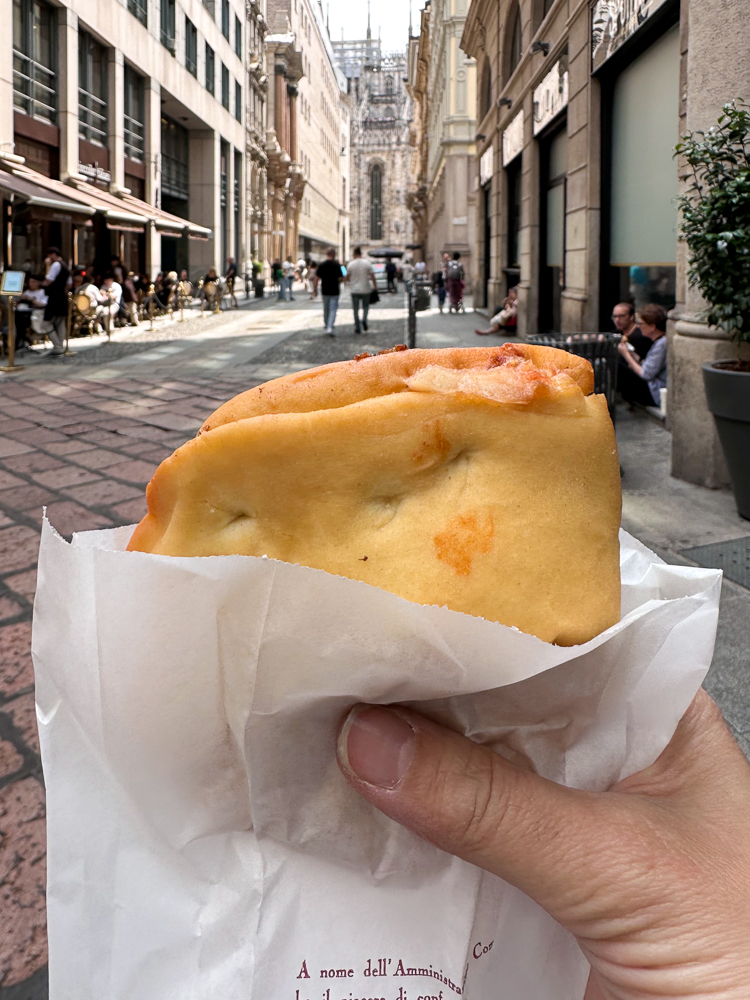
You simply cannot walk in and around the streets of Galleria Vittorio Emanuele II and La Scala without stopping for a couple of panzerotti from Luini.
Panzerotti are like mini calzones from Italy’s Puglia region. The dough forms a pocket in which things like mozzarella, tomato, meats, and vegetables are stuffed. The dough is fried for a blissfully indulgent snack or lunch (they’re that filling)!
There’s usually a line running out the door but it moves fast so don’t fret! You’ll have your hands on these goodies in no time. The mozzarella and pomodoro (tomato) is the classic variety but I have yet to try one that disappointed!
You could grab a few and head to Piazza delle Scala to sit in the square and feast on your favorite new Italian food!
Museo del Novecento
Located in Piazza del Duomo, the Museo del Novecento is a modern museum with a collection of 4000+ works displaying the development of 20th-century Italian art. If you’re a lover of modern art, I recommend spending a little time here. You’ll undoubtedly come away having discovered some artists that weren’t previously on your radar.
Besides the works of art themselves, the museum’s building, Palazzo dell’Arengario, has floor-to-ceiling windows from which you can admire the entirety of Piazza Duomo, the cathedral, and the entrance of Galleria Vittorio Emanuele II.
Tickets can be purchased online or at the ticket office.
ProTip: Don’t overwhelm yourself with too many museum visits in a single day. The Teatro alla Scala Museum and the Museo del Novecento speak to different tastes. Choose 1 (if either) to go inside and spend more time. By focusing your time in one place, you’ll inevitably get more out of the visit.
Santuario di San Bernardino alle Ossa
Just a short walk from the Duomo, you’ll come upon the Sanctuary of San Bernardino alle Ossa in the Piazza Santo Stefano.
The Ossuary is in the church next to the Basilica of Santo Stefano Maggiore and dates back to the year 1210. With the local cemetery filling with bodies from the nearby hospital, a room was built to hold the bones. Later a church was built alongside it and then rebuilt in the 1700s when a fire destroyed the original church leaving the ossuary intact.
Today, it’s one of the most grisly sights in Milan with bones and skulls covering nearly all open walls, pillars, and doorways of the Ossuary, except for the 17th-century frescoes on the ceiling. And while the church itself is not especially noteworthy, the ossuary at the end of the narrow hallway on the right side of the entryway is sure to fascinate and perhaps even chill you…to the bone!
Chiesa di Santa Maria presso San Satiro
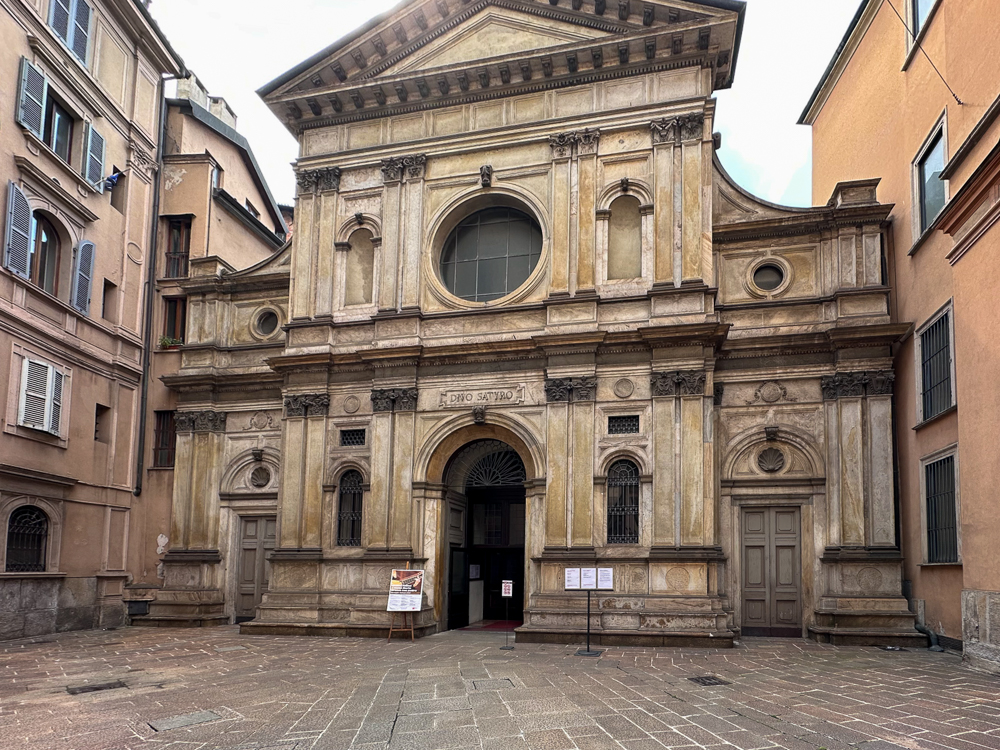
It’s easy to miss this Italian Renaissance church set back off a tiny alleyway from one of Milan’s busy shopping streets, Via Torino. The church was finished in the 1480s and was an impressive feat given the small space with which the church needed to fit.
Yet, as you walk inside the church, you’d never realize the space the church is lacking at first glance. The exact opposite, in fact, because of a painted optical illusion behind the altar to make the church appear deeper than it actually is. Upon getting a closer look, you realize the trick, as well as recognize the genius behind the design.
The Church of Santa Maria preso San Satiro is less than 5 minutes on foot from the Duomo making it easy to admire this historic church and its artistry.
Ambrosian Library

This Milan jewel is one that often gets overlooked which is such a pity! But for those in the know, it’s like striking gold in the heart of Milan.
The museum and library hold paintings by Da Vinci, Botticelli, and Caravaggio, as well as numerous manuscripts and historical artifacts like a lock of hair from the infamous, misunderstood Lucrezia Borgia; the illegitimate daughter of Pope Alexander VI. (It’s rumored she returns at night to comb her lock of hair!)
One of the most stunning pieces on display is the restored School of Athens Cartoon by Raphael. This 26-foot by 9-foot drawing is entirely done by Raffaello (Raphael), himself. He did it in preparation for eventually painting the famous scene as a fresco in the Vatican. The cartoon is absolutely mesmerizing and the exhibit also features multi-media that highlights and explains specific people and notable details.
In the library, there are sketches done by Da Vinci on display. In fact, the library is home to the entire Codex Atlanticus, a 12-volume set of Da Vinci’s drawings and writing that gives fascinating insights into his genius.
If there’s 1 museum you choose to spend time in on Day 1 of your 2-day Milan itinerary, make it this one! In just a 5-minute walk from the Duomo and as little as 1 hour to spare, you’ll have uncovered one of the best-kept secrets in Milan. Tickets can be purchased online or at the museum.
Cripta di San Sepolcro
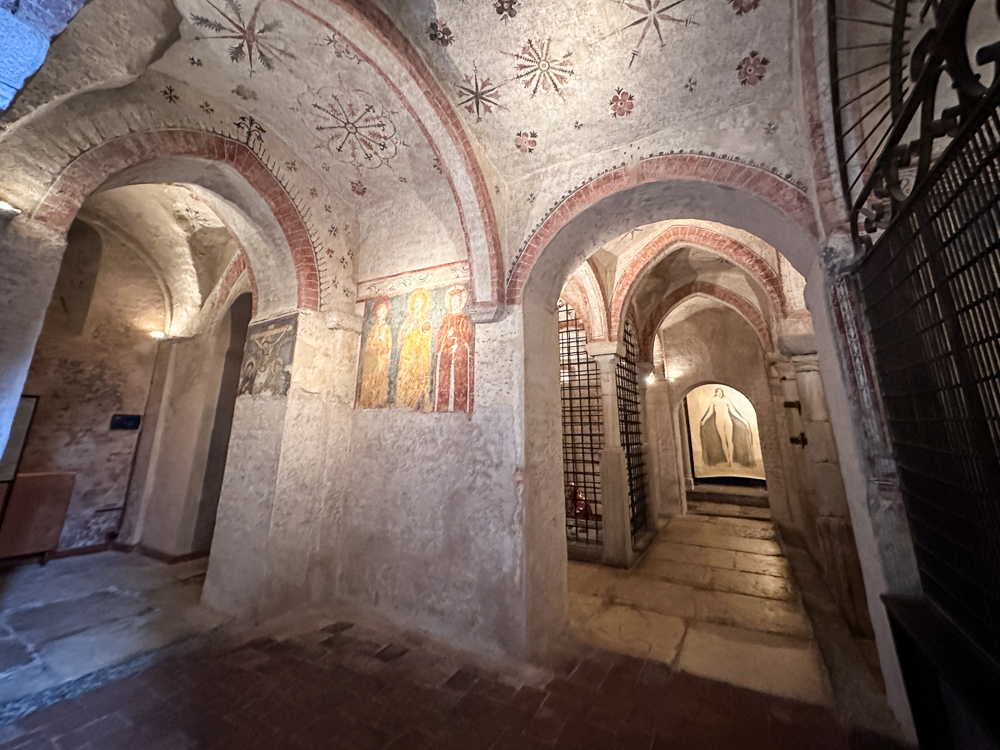
Adjacent to the Ambrosian Library is the Cripta di San Sepolcro, an underground church dating back to the year 1030. You can purchase a combination ticket for the Ambrosian Libary and the crypt and flow directly from one place to the next.
The crypt was built upon the remnants of the ancient city of Mediolanum, the name given to Milan when it was conquered by the Romans in 222 B.C. Today, what you’ll see are floors that are from Roman times and frescoes from the 11th century. Leonardo Da Vinci also made drawings of the crypt confirming for historians that it was at the true center of the ancient city.
Piazza Mercanti
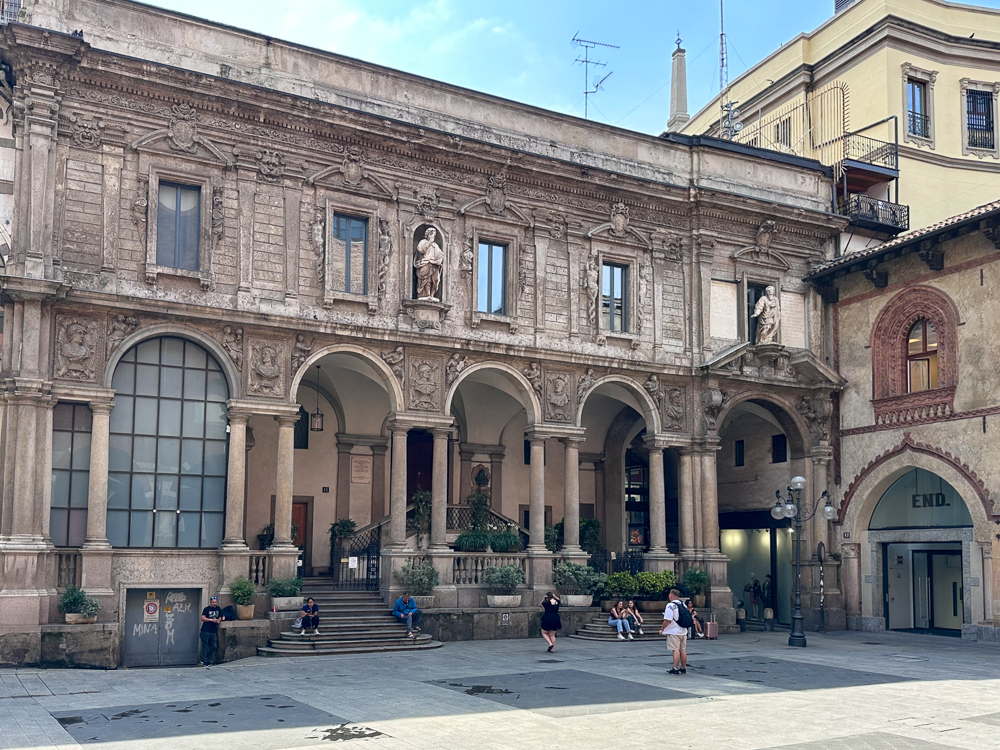
Piazza Mercanti is an important piece of Milan’s medieval history and once was the city’s true center. Parts of the square date back to the 1200s (predating the Duomo!) and were once a bustling hive of commercial, political, and daily life activities. This “merchants” square had a market, governmental buildings including a courthouse, and a school among others. Six arteries of the city ran from this center square to different city gates along Milan’s exterior.
Notably, it was also the area of medieval Milan where you might see someone being publicly shamed (i.e. bare-bottomed) for an offense like bankruptcy.
Admittedly, the square seems a bit forgotten. There are a few signs but it’s not publicized in the same way as other historic spots around the city. Still, it’s worth a pass-through because it helps remind you of Milan’s deep historic roots even when so many other things around it seem more modern and new. Plus, it’s just a 3-minute walk from the Duomo and brings you nearly full circle should you make this your last sightseeing stop of the day.
ProTip: From Piazza Mercanti, navigate to the Cordusio M1 (red) metro station. Switch at Cadorna FN to the M2 (green) metro line to the P.TA Genova FS station. From there, walk to the canal in Navigli. Also note, ending the day’s loop at Piazza Mercanti, near the Duomo, gives you the opportunity to freshen up at your hotel (if you’re staying in this area) before heading out for an aperitivo and/or dinner.
Navigli

The best way to finish the 1st day of your Milan itinerary is in one of the city’s most famous districts: the Navigli. Naviglio Grande, the famous canal, is less than a 10-minute walk away from the P.TA Genova metro station.
The Navigli is one of the places where the Milanese go for nightlife. At around 6 p.m. every afternoon, Navigli’s quiet paths are packed with locals and visitors doing the traditional aperitivo. The aperitivo consists of ordering a drink and getting small plates of food (like antipasti – appetizers – and snacks) on the side. The aperitivo is technically pre-dinner, so if you take part in this tradition, don’t forget to have a proper dinner after!
Milanese love the aperitivo so much that they have invented something called “apericena” which is an aperitivo turned into a proper meal! You pick your cocktail, and then you will have to choose from a wide variety of plates, ranging from pasta to bruschetta.
In addition to eating and drinking along the canal, stroll into the small shops and onto the side streets. You’ll find a mix of vintage clothing shops, used bookstores, and artist studios to name a few.
The Navigli is without a doubt one of the best places in Milan to spend an evening and reflect on a day well spent in Milan.
2 Days in Milan – Day 2
Today, your Milan itinerary includes one of the greatest artistic masterpieces of all time, high fashion, and an up-close look at the contrast between the city’s historic and modern sides. Like yesterday, the day’s plan includes top sights and some places that are a bit lesser known to help you get a deeper feel for what Milan is all about.
The distance traveled on Day 2 will be more than yesterday which is why I will mention how to get to and from some places by metro. You can also certainly walk the entire route if you choose, depending on your timing.
Santa Maria delle Grazie and the Last Supper
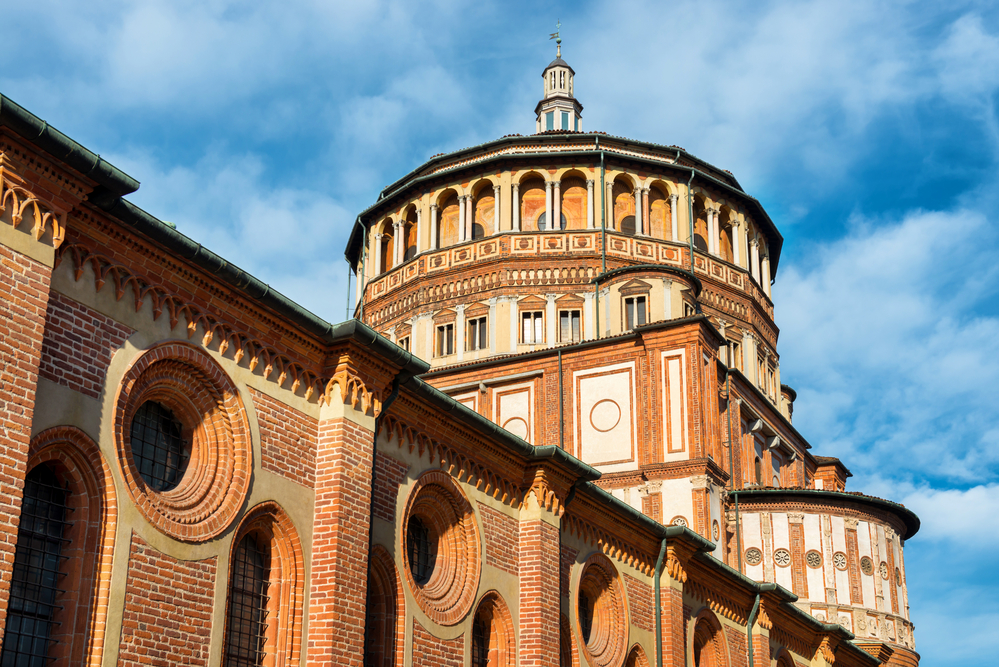
The day (hopefully!) starts with one of Milan’s and the world’s treasures, the Basilica di Santa Maria delle Grazie and Leonardo Da Vinci’s Last Supper painting.
The Basilica di Santa Maria delle Grazie belongs to the Dominican Order and in 1980 was named a UNESCO World Heritage Site. The Renaissance-style church dates back to 1497 when it was completed. Leonardo Da Vinci’s Last Supper (Cenacolo Vinciano or L’Ultima Cena in Italian) inside the Basilica only adds to the significance of this historic and cultural gem.
Painted directly onto one of the Basilica’s walls in the Great Hall, the mural is nearly 30 feet long and 13 feet tall. L’Ultima Cena is a breathtaking piece of artwork; standing in front of it, you will have the sensation that the characters of the painting are moving!
As noted at the top of this guide, a reservation is mandatory. Blocks of tickets become available to reserve every three months. Once open, tickets sell out quickly. This guide about how to get Last Supper tickets walks you through all of your options and the necessary steps.
But if you check the official website for the Last Supper and no tickets are available, look to see the Last Supper with a guide. Tour companies have groups of tickets that may still be available for a particular day and time even when the official website says there are no more tickets left.
Ideally, you’d visit the Last Supper in the morning as the first thing on your agenda. This allows you to go about your day in a logical route without having to backtrack or worry about making it on time later in the day.
ProTip: The closest metro stop to the Last Supper (Cenacolo Vinciano) is the Conciliazione station on the M1 (red) line. This is the same line that makes a stop at the Duomo in case your hotel is in that area.
Leonardo Da Vinci’s Vineyard
If you’ve just come from seeing the Last Supper in the Basilica across the street, then consider lingering in the area for a bit more imagining about the life of Da Vinci.
Having been commissioned by the Duke of Milan to paint the Last Supper, he also gave Leonardo Da Vinci a small vineyard just across the street from Santa Maria Delle Grazie. Leonardo tended to his grapes while he painted and worked during his 17 years in Milan. By all accounts, he loved his vineyard and went to great lengths to get it back after the French conquered the city and made arrangements for it as he was dying.
Today, archaeological work has been done to restore the Casa degli Atellani and replant the exact type of vines in their original positions as when Leonardo was alive. A couple of rooms and the garden can be visited to add another layer and perspective to your understanding of the life of this incredible man and artist.
For a weekend visit, you must reserve tickets in advance. Otherwise, tickets can be purchased online (the best option for guaranteed entry) or in person.
Church of San Maurizio al Monastero Maggiore

Cities and towns throughout Italy are home to countless beautiful churches, cathedrals, chapels, and the like. After seeing a few, your eye becomes more skilled at recognizing the ones that truly rise above the rest. This is the case with the stunning Church of San Maurizio al Monastero Maggiore. It’s just a few minutes on foot from the Last Supper and it’s not to be missed!
The church itself was completed in 1518 and is split into 2 parts by a dividing wall, the worshippers on one side and the nuns belonging to the adjoined monastery on the other. However, within the grounds of the church and monastery, you’ll find remnants from Roman times including walls and towers that were incorporated into the existing structures.
The contrast between the church’s solemn facade and the breathtaking 16th-century frescoes inside can feel like quite a shock! From the street, you’d never imagine the incredible artwork that awaits. Colors brought vividly back to life after a 30-year restoration process that began in 1985 spring from the walls, ceilings, and every inch of available space. Aptly named “the Sistine Chapel of Milan,” the frescoes were nearly entirely painted by Bernardino Luini who was a part of Da Vinci’s inner circle, as well as a student at his school.
This is arguably the most beautiful church you’ll see in Milan, yet remains under the radar of many who visit the city.
ProTip: Milan’s Archaeological Museum is just next door as you exit in the former monastery. The museum is small but has a lot of interesting artifacts and information (in English) about Milan’s history going back to Roman times.
Castello Sforzesco
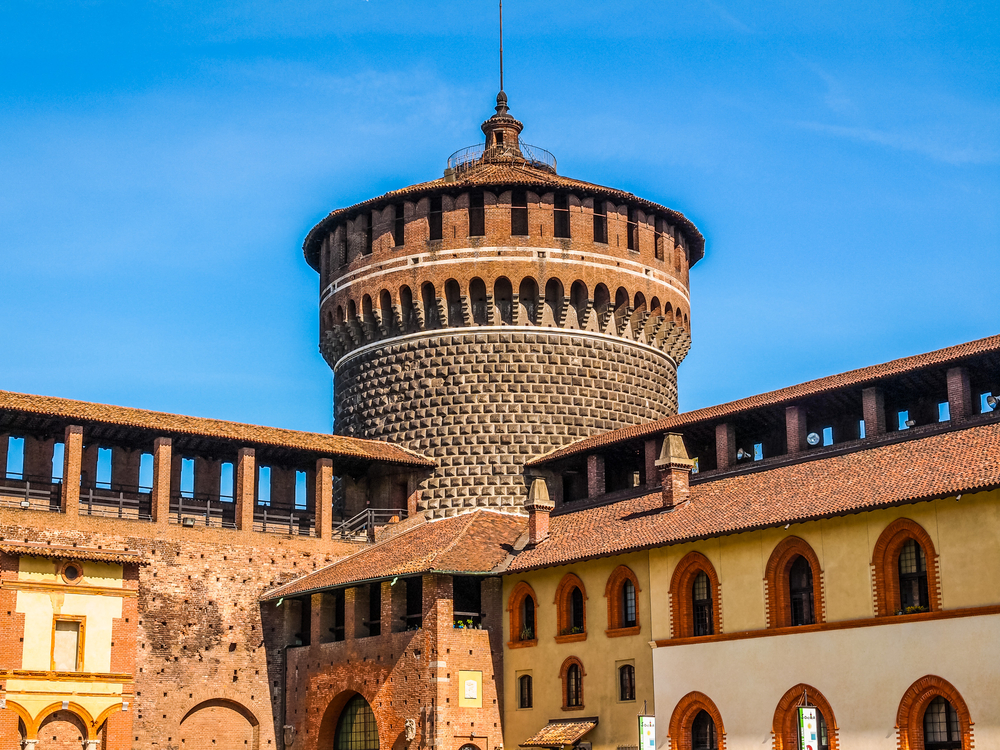
The Castello Sforzesco is less than a 10-minute walk from San Maurizio al Monastero Maggiore. (Although, a slight gelato detour to Chocolat Milano is absolutely worth it!)
Built in the 15th century, Castello Sforzesco initially was used as a military stronghold. Today, though, it houses several museums and galleries, as well as being a monument to history with its accessible castle towers, walls, and ramparts. Sforza Castle is one of the largest in all of Europe and is free to access its grounds. The museum ticket costs only €5 (full admission) and gets you into all the museums inside.
Within the castle’s rooms, you’ll find an incredible collection of paintings, furnishings, decorative arts, tapestries, sculptures, and archaeological treasures. Michelangelo’s Pietà Rondanini is on display inside the Castello Sforzesco, which I highly recommend as your first stop within the vast cultural complex.
The Sala delle Asse is another top spot, with frescoes painted by Leonardo Da Vinci who lived and worked at the castle during his time in Milan. (In 2023, this room is currently undergoing restoration although it may be possible to get an obstructed glimpse as you pass through the room.)
ProTip: Sforza Castle can feel overwhelming when you first arrive because there are so many areas to visit. In fact, you could easily spend the better part of a day here. Make a plan and know which are the top spots to see. You can also get an audioguide with your ticket so that you have information about different areas of the castle and the collections inside. Lastly, you can book a guided visit to help focus your time at the castle.
Parco Sempione
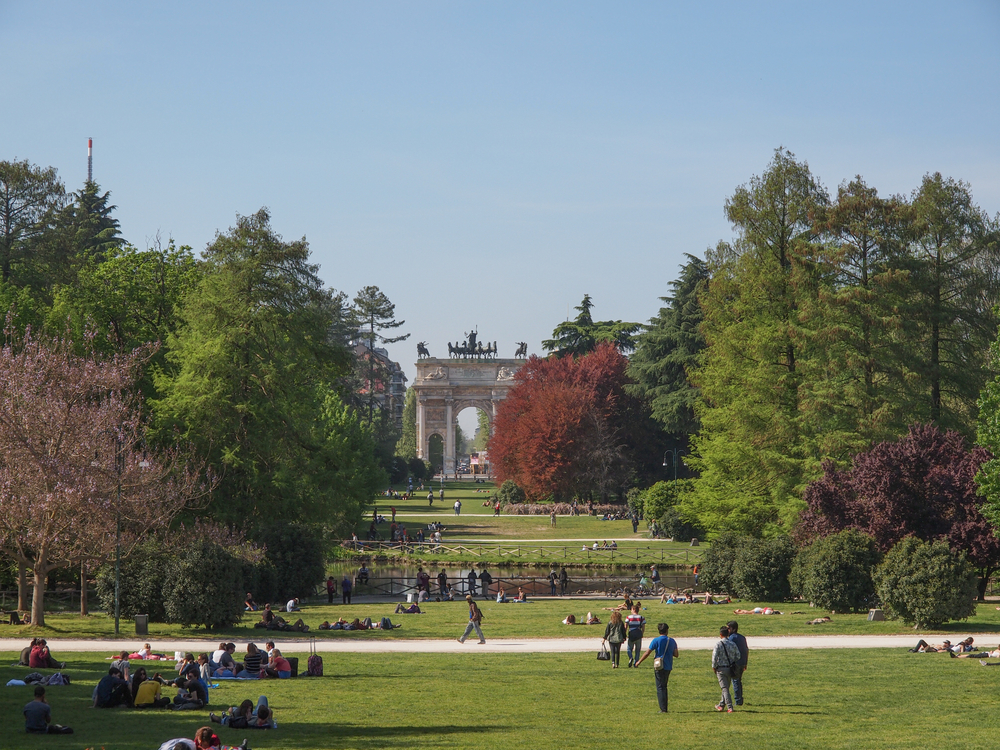
If you exit to the back of the castle, you’ll find Milan’s prized green space, Parco Sempione. The park’s bike paths, pedestrian walkways, picnics, and cafes are a beloved retreat for Milanese and visitors alike.
But beyond the 38 acres of greenery, Sempione Park is home to several important landmarks.
First, it’s the link between the 19th-century Arco della Pace and Castello Sforzesco. Located at the northwest end of the park, the Arco della Pace marks the gateway to the city, and its history is linked to the 1815 Congress of Vienna. The Arco was dedicated to commemorate the peace agreement signed among European nations.
As you walk in the park, you’ll come upon the Triennale Milano which is an art and design museum. The nearby Branca Tower was built in the 1930s and represents modern ideas of architecture. There’s also a library and an aquarium inside the park.
While this itinerary for 2 days in Milan doesn’t include time to visit Triennale Milano or the aquarium, a brief stroll in the park at least to see the Arco della Pace is worth the time and effort.
Via Monte Napoleone and the Quadrilatero della Moda
After you visit Castello Sforzesco and Parco Sempione, head to one of the most iconic streets in Milan: via Monte Napoleone.
You can reach Via Monte Napoleone on foot in about 25 minutes or jump on the M1 (red) metro train from Cairoli to San Babila. From there, Via Monte Napoleone and Milan’s Quadrilatero della Moda, or high fashion district, is just a couple of minutes’ walk.
Via Monte Napoleone along with Via Manzoni, Via della Spiga, and Corso Venezia form the Quadrilatero della Moda. Here you’ll find designer boutiques for luxury brands like Versace, Prada, Gucci, Valentino, and many others.
Milan is always at the forefront of the fashion industry, and a visit to the city needs to include some (windows) shopping! So enjoy a stroll along the popular via Monte Napoleone, and – if you fancy – make a stop at Pasticceria Cova, a historic and elegant pastry shop that makes an incredibly delicious panettone, if you happen to visit the city at Christmas!
But if you prefer to avoid any shopping temptations, feel free to go directly to Pinacoteca di Brera from Parco Sempione. It’s about a 10-15 minute walk from the park and castle area.
ProTip: As you plan your 2 days in Milan, you could consider some time in the Quadrilatero della Moda on Day 1 of your itinerary. If you don’t plan to go inside La Scala or the Museo del Novecento, you can easily detour here for some high-fashion time before continuing back along the day’s suggested framework. Alternatively, if your goal in Milan is to shop, you might be interested in a day trip to the popular Serravalle Designer Outlet.
Pinacoteca di Brera
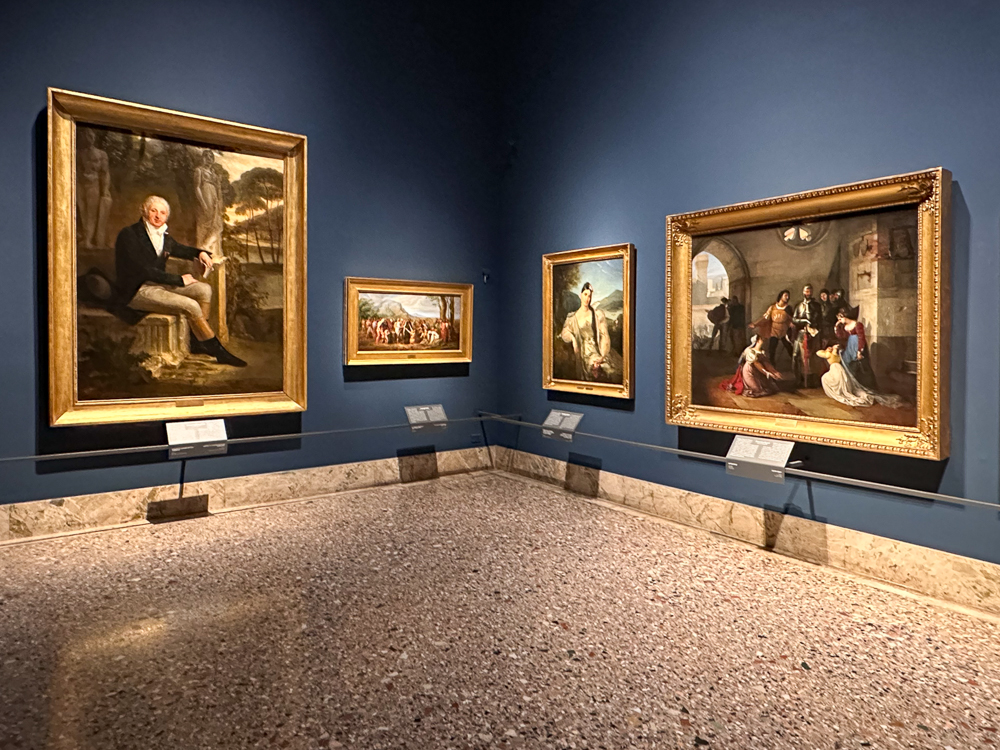
Leaving the Quadrilatero della Moda behind you, it’s time to visit the Pinacoteca di Brera, one of the most important art museums in Milan. It’s just a 10-minute walk on foot.
The Pinacoteca is a renowned art gallery where you can admire all the splendor of Italian art. The collection is spread over a single floor and divided into 38 exhibition rooms. Highlights include the spectacular “The Kiss” by Hayez, “Marriage of the Virgin” by Raphael, Caravaggio’s “Supper at Emmaus,” and the “Dead Christ” by Mantegna with its interesting perspective.
Besides the pieces of art in the museum, you’ll find some of the best signage you’ll see in any museum. Descriptions are available in Italian and English, but better still, many pieces offer additional commentary with interesting facts, perspectives, and questions to help you contemplate the work of art in front of you.
There’s also a library often referred to as the Biblioteca di Brera which you can visit before you enter the museum’s first rooms. While you can’t see the whole space, the large library room near the entrance to the museum sometimes has temporary exhibitions with historic books and manuscripts which tend to be quite interesting.
ProTip: The museum is in a section of the Palazzo Brera which is a beautiful 17th-century building with grand corridors, porticoes, an internal courtyard, and ornate detailing throughout. In the back, there is also the Brera Botanical Garden. This small garden space has been a place for scientific and medicinal plant studies, as well as quiet contemplation. If you have a few moments, it’s worth a quick look.
Cimitero Monumentale di Milano
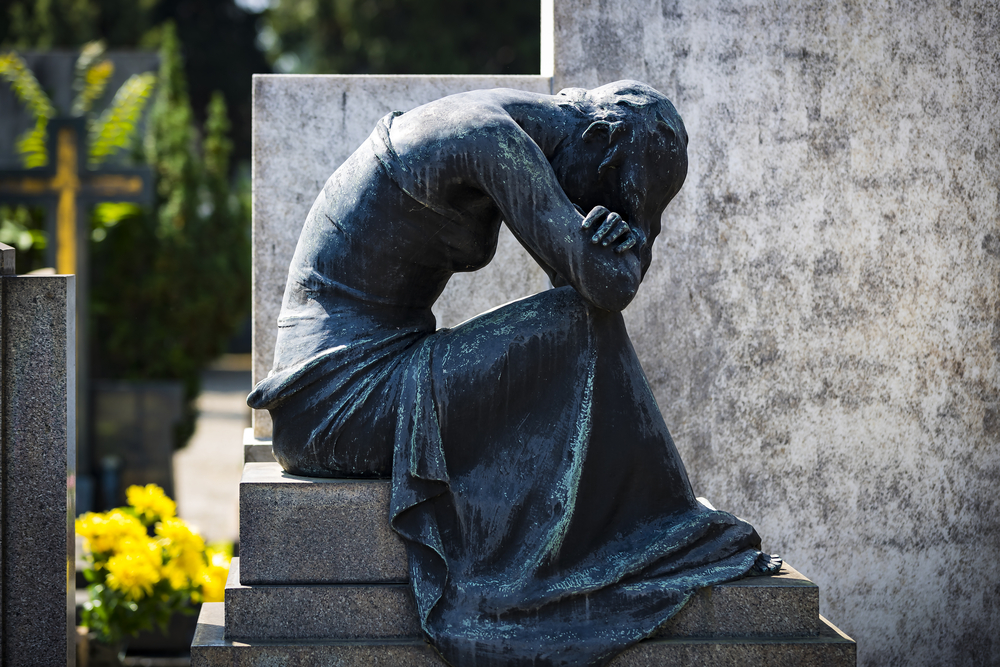
I bet when you asked about what to do in Milan in 2 days, you never imagined you’d see a suggested cemetery visit on the list! But as it goes in Italy, you can find beauty just about everywhere you look.
The Cimitero Monumentale is an open-air museum with beautifully decorated tombs and monuments. The cemetery was designed by the Italian architect, Carlo Maciachini. He used a Neoclassical style for the main building and the mausoleum, with some Byzantine, Gothic, and Lombard influences as well. And, the classic sculptures and monuments adorning the tombs throughout the cemetery rival those found in top museums.
Monumental Cemetery covers about 62 acres and is the final place of rest for some of the most important names in Milanese history, including Alessandro Manzoni, Gaspare Campari, and Salvatore Quasimodo. As you walk the wide paths, the serenity combined with the carved angels, a life-like bronze cast of the Last Supper, Greek-style towers, and carvings depicting the Stations of the Cross will make you feel miles away from Milan’s city center.
To get from the Pinacoteca di Brera to the Cimitero Monumentale, I recommend using the metro. Take the M2 (green) metro line from Lanza to Garibaldi F.S., and then change to the M5 line (purple) until you reach the Monumentale stop. Otherwise, on foot, prepare for a 25-minute walk to the cemetery.
Piazza Gae Aulenti & the Isola District
As you round out your 2nd day in Milan, head toward the Piazza Gae Aulenti. It’s just a 10-minute walk from Cimitero Monumentale or a quick metro ride from Monumentale to Garibaldi F.S.
This is where you’ll come face to face with the modern side of Milan. Piazza Gae Aulenti is the central square in Milan’s Isola district. You’ll see the city’s tallest skyscraper and the iconic Vertical Forest apartment buildings that are covered in greenery. In the square, shops and eateries surround a contemporary design that includes open space, paths, and water elements.
If you haven’t had your day’s gelato yet, Grom has the deliciousness you need! And as it is when you’re in Milan, the late afternoon calls for an aperitivo!
The streets in the Isola neighborhood on the backside of Porta Garibaldi and Piazza Gae Aulenti are animated by street art, craft shops, traditional and ethnic restaurants, countless bars where you can have a fantastic aperitivo, and nightclubs. Popular spots include Bar Frida or the Blue Note for some jazz.
After seeing the best of Milan in 2 days, use the metro to return to the city center. From the Milano Repubblica M3 (yellow) station just a short walk from Piazza Gae Aulenti, you can get a nonstop ride back to the Duomo in minutes. Or take the M2 (green) from Garibaldi F.S. to Centrale F.S. and transfer to the M3 to reach the Duomo.
What’s Next on Your Northern Italy Itinerary?

Milan has the incredible advantage of being one of the most well-connected cities in Italy. You can catch a train and in about one hour arrive at some of the most stunning locations in northern Italy. Cities like Bologna and Torino are easily within reach.
You could also plan a day trip from Milan to Lake Como.
Liguria and its beautiful coastline including the Cinque Terre can be reached by train from Milan. Several high-speed trains run from Milan to Venice each day. Or venture off to beautiful Verona, Bergamo, or Lake Garda to discover more of northern Italy’s countless gems.
Bottom Line: 2-Day Itinerary for Milan
Aside from its fame as a fashion capital of the world, Milan is home to countless historic, architectural, and artistic gems! Spending 2 days in Milan is the perfect way to experience the best of what the city has to offer.
So, what questions do you have about your Milan itinerary?
Like this guide? Please share on social media!
